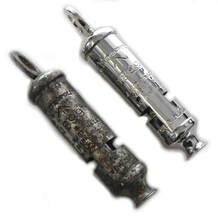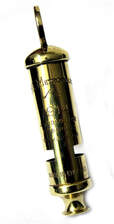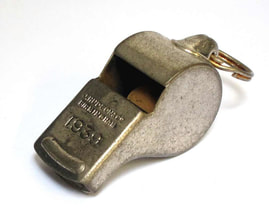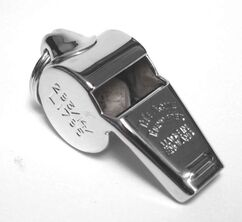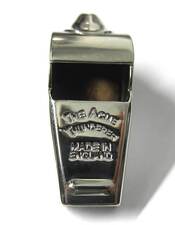War Whistles History
China & Ancient Egypt:
It is thought that night watchmen in Ancient China would blow into the tops of acorns to alert the towns to invading Mongolians, This 'whistle' was used in the third century. In ancient Egypt two blades of the papyrus plant found along the Nile river were held together in between the palms. By blowing into the palms the papyrus leaves would make a loud signalling sound. Bird-bone whistles were played in the 12th century in Dublin, Ireland, thought to have been imported by the Vikings.
Navy & Crusades:
The boatswain's pipe whistle was used aboard naval vessels to issue commands and salute dignitaries and is still used today in modern Navies. It is thought to have developed from pipes used in ancient Greece and Rome to keep the stroke of galley slaves. In medieval times whistles were used during the Crusades to assemble English crossbow men on deck for an attack.
World War One:
During WW1, the Army used whistles to signal the infantry to go 'over the top', in other words, leave the trenches and advance to contact with the enemy. They also used different tones of whistle's to coordinate troop movements, with platoon & section leaders using 'Thunderer' whistles, Company Commanders using 'Kinglet' whistles and even Battalion Commanders using siren whistles.
World War Two:
Many whistles were used by many branches of the armed forces and civil units during WW2. These included, the Army, Navy, Royal Air Force and United States Air Forces, who used them as emergency signalling whistles and had them attached to their uniforms or equipment. The Air Raid Precations (ARP) and Fire Service used them to signal air raids and dropping of incendiary bombs. More information on: RAF & Commonwealth Whistles used in WW2 and USAAF & USAAC Whistles used in WWII.
United Kingdom - Hudson & Co was founded in the 1870s in Birmingham:
Joseph Hudson started working at the age of 12. He moved to Bent & Parker, a maker of army supplies and whistles in Birmingham. In 1870, aged 22, he started his own business with younger brother James. Around 1875, he designed the 'Acme City' brass whistle. This became the first referee whistle to be used at football matches during the 1878-78 Football Association Cup match between Nottingham Forest and Sheffield. Prior to the introduction of the whistle, handkerchiefs or flags were used by the umpires to signal to the players.
In 1883 Hudson began tinkering in his workshop to make gadgets to sell, including whistles. After observing local police struggling to communicate with rattles, he realised that his whistle could be used as a signalling tool. Hudson, also a violin player, accidentally dropped his violin and it shattered on the floor. Observing how the discordant sound of the breaking strings travelled, Hudson had the idea to put a pea in the whistle. This gave it an ear splitting rattle that could grab attention even a mile away. After a demonstration at Scotland Yard, Hudson had his first sale. The 'Metropolitan', was invented by Joseph Hudson. The whistle was adopted by most Police Forces in the United Kingdom.
This 1884 contract with the police gradually made Hudson the largest whistle manufacturer for British Empire Police and other general services. His whistles are still used by many forces worldwide. His design, was improved as the 'Acme Thunderer', the first ever pea whistle, which remains the most used whistle in the world; for train guards, dog handlers and police officers.
During WW1, Hudson & Co produced the Hudson Officer’s trench Whistle. The Whistles normally had “J Hudson”, “Birmingham” and the Date of the Whistle stamped on the front. The patent number is sometimes stamped on the top of the whistle. A leather strap or lanyard would sometimes be connected to the whistle so that a soldier could attach it to his uniform.
A. De Courcy & Co of Birmingham, England also produced trench whistles in WWI, their name and trademark have since been bought out by J Hudson & Co (ACME Whistles).
Please use the categories below if you are looking for information on specific war whistles:
It is thought that night watchmen in Ancient China would blow into the tops of acorns to alert the towns to invading Mongolians, This 'whistle' was used in the third century. In ancient Egypt two blades of the papyrus plant found along the Nile river were held together in between the palms. By blowing into the palms the papyrus leaves would make a loud signalling sound. Bird-bone whistles were played in the 12th century in Dublin, Ireland, thought to have been imported by the Vikings.
Navy & Crusades:
The boatswain's pipe whistle was used aboard naval vessels to issue commands and salute dignitaries and is still used today in modern Navies. It is thought to have developed from pipes used in ancient Greece and Rome to keep the stroke of galley slaves. In medieval times whistles were used during the Crusades to assemble English crossbow men on deck for an attack.
World War One:
During WW1, the Army used whistles to signal the infantry to go 'over the top', in other words, leave the trenches and advance to contact with the enemy. They also used different tones of whistle's to coordinate troop movements, with platoon & section leaders using 'Thunderer' whistles, Company Commanders using 'Kinglet' whistles and even Battalion Commanders using siren whistles.
World War Two:
Many whistles were used by many branches of the armed forces and civil units during WW2. These included, the Army, Navy, Royal Air Force and United States Air Forces, who used them as emergency signalling whistles and had them attached to their uniforms or equipment. The Air Raid Precations (ARP) and Fire Service used them to signal air raids and dropping of incendiary bombs. More information on: RAF & Commonwealth Whistles used in WW2 and USAAF & USAAC Whistles used in WWII.
United Kingdom - Hudson & Co was founded in the 1870s in Birmingham:
Joseph Hudson started working at the age of 12. He moved to Bent & Parker, a maker of army supplies and whistles in Birmingham. In 1870, aged 22, he started his own business with younger brother James. Around 1875, he designed the 'Acme City' brass whistle. This became the first referee whistle to be used at football matches during the 1878-78 Football Association Cup match between Nottingham Forest and Sheffield. Prior to the introduction of the whistle, handkerchiefs or flags were used by the umpires to signal to the players.
In 1883 Hudson began tinkering in his workshop to make gadgets to sell, including whistles. After observing local police struggling to communicate with rattles, he realised that his whistle could be used as a signalling tool. Hudson, also a violin player, accidentally dropped his violin and it shattered on the floor. Observing how the discordant sound of the breaking strings travelled, Hudson had the idea to put a pea in the whistle. This gave it an ear splitting rattle that could grab attention even a mile away. After a demonstration at Scotland Yard, Hudson had his first sale. The 'Metropolitan', was invented by Joseph Hudson. The whistle was adopted by most Police Forces in the United Kingdom.
This 1884 contract with the police gradually made Hudson the largest whistle manufacturer for British Empire Police and other general services. His whistles are still used by many forces worldwide. His design, was improved as the 'Acme Thunderer', the first ever pea whistle, which remains the most used whistle in the world; for train guards, dog handlers and police officers.
During WW1, Hudson & Co produced the Hudson Officer’s trench Whistle. The Whistles normally had “J Hudson”, “Birmingham” and the Date of the Whistle stamped on the front. The patent number is sometimes stamped on the top of the whistle. A leather strap or lanyard would sometimes be connected to the whistle so that a soldier could attach it to his uniform.
A. De Courcy & Co of Birmingham, England also produced trench whistles in WWI, their name and trademark have since been bought out by J Hudson & Co (ACME Whistles).
Please use the categories below if you are looking for information on specific war whistles:
